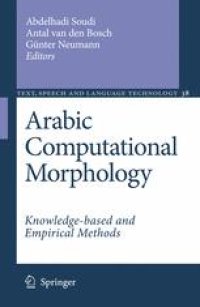
Ebook: Arabic Computational Morphology: Knowledge-based and Empirical Methods
- Tags: Computational Linguistics, Arabic, Language Translation and Linguistics, Semitic Languages, Information Storage and Retrieval
- Series: Text Speech and Language Technology 38
- Year: 2007
- Publisher: Springer Netherlands
- Edition: 1
- Language: English
- pdf
The morphology of Arabic poses special challenges to computational natural language processing systems. The exceptional degree of ambiguity in the writing system, the rich morphology, and the highly complex word formation process of roots and patterns all contribute to making computational approaches to Arabic very challenging. Indeed many computational linguists across the world have taken up this challenge over time, and many of the researchers with a track record in this research area have contributed to this book.
The book’s subtitle aims to reflect that widely different computational approaches to the Arabic morphological system have been proposed. These accounts fall into two main paradigms: the knowledge-based and the empirical. Since morphological knowledge plays an essential role in any higher-level understanding and processing of Arabic text, the book also features a part on the role of Arabic morphology in larger applications, i.e. Information Retrieval (IR) and Machine Translation (MT).
The morphology of Arabic poses special challenges to computational natural language processing systems. The exceptional degree of ambiguity in the writing system, the rich morphology, and the highly complex word formation process of roots and patterns all contribute to making computational approaches to Arabic very challenging. Indeed many computational linguists across the world have taken up this challenge over time, and many of the researchers with a track record in this research area have contributed to this book.
The book’s subtitle aims to reflect that widely different computational approaches to the Arabic morphological system have been proposed. These accounts fall into two main paradigms: the knowledge-based and the empirical. Since morphological knowledge plays an essential role in any higher-level understanding and processing of Arabic text, the book also features a part on the role of Arabic morphology in larger applications, i.e. Information Retrieval (IR) and Machine Translation (MT).
The morphology of Arabic poses special challenges to computational natural language processing systems. The exceptional degree of ambiguity in the writing system, the rich morphology, and the highly complex word formation process of roots and patterns all contribute to making computational approaches to Arabic very challenging. Indeed many computational linguists across the world have taken up this challenge over time, and many of the researchers with a track record in this research area have contributed to this book.
The book’s subtitle aims to reflect that widely different computational approaches to the Arabic morphological system have been proposed. These accounts fall into two main paradigms: the knowledge-based and the empirical. Since morphological knowledge plays an essential role in any higher-level understanding and processing of Arabic text, the book also features a part on the role of Arabic morphology in larger applications, i.e. Information Retrieval (IR) and Machine Translation (MT).
Content:
Front Matter....Pages I-VIII
Front Matter....Pages 1-1
Arabic Computational Morphology: Knowledge-based and Empirical Methods....Pages 3-14
On Arabic Transliteration....Pages 15-22
Issues in Arabic Morphological Analysis....Pages 23-41
Front Matter....Pages 43-43
A Syllable-based Account of Arabic Morphology....Pages 45-66
Inheritance-based Approach to Arabic Verbal Root-and-Pattern Morphology....Pages 67-88
Arabic Computational Morphology: A Trade-off Between Multiple Operations and Multiple Stems....Pages 89-114
Grammar-Lexis Relations in the Computational Morphology of Arabic....Pages 115-140
Front Matter....Pages 141-141
Learning to Identify Semitic Roots....Pages 143-158
Automatic Processing of Modern Standard Arabic Text....Pages 159-179
Supervised and Unsupervised Learning of Arabic Morphology....Pages 181-200
Memory-based Morphological Analysis and Part-of-speech Tagging of Arabic....Pages 201-217
Front Matter....Pages 219-219
Light Stemming for Arabic Information Retrieval....Pages 221-243
Adapting Morphology for Arabic Information Retrieval* ....Pages 245-262
Arabic Morphological Representations for Machine Translation....Pages 263-285
Arabic Morphological Generation and its Impact on the Quality of Machine Translation to Arabic....Pages 287-302
Back Matter....Pages 303-305
The morphology of Arabic poses special challenges to computational natural language processing systems. The exceptional degree of ambiguity in the writing system, the rich morphology, and the highly complex word formation process of roots and patterns all contribute to making computational approaches to Arabic very challenging. Indeed many computational linguists across the world have taken up this challenge over time, and many of the researchers with a track record in this research area have contributed to this book.
The book’s subtitle aims to reflect that widely different computational approaches to the Arabic morphological system have been proposed. These accounts fall into two main paradigms: the knowledge-based and the empirical. Since morphological knowledge plays an essential role in any higher-level understanding and processing of Arabic text, the book also features a part on the role of Arabic morphology in larger applications, i.e. Information Retrieval (IR) and Machine Translation (MT).
Content:
Front Matter....Pages I-VIII
Front Matter....Pages 1-1
Arabic Computational Morphology: Knowledge-based and Empirical Methods....Pages 3-14
On Arabic Transliteration....Pages 15-22
Issues in Arabic Morphological Analysis....Pages 23-41
Front Matter....Pages 43-43
A Syllable-based Account of Arabic Morphology....Pages 45-66
Inheritance-based Approach to Arabic Verbal Root-and-Pattern Morphology....Pages 67-88
Arabic Computational Morphology: A Trade-off Between Multiple Operations and Multiple Stems....Pages 89-114
Grammar-Lexis Relations in the Computational Morphology of Arabic....Pages 115-140
Front Matter....Pages 141-141
Learning to Identify Semitic Roots....Pages 143-158
Automatic Processing of Modern Standard Arabic Text....Pages 159-179
Supervised and Unsupervised Learning of Arabic Morphology....Pages 181-200
Memory-based Morphological Analysis and Part-of-speech Tagging of Arabic....Pages 201-217
Front Matter....Pages 219-219
Light Stemming for Arabic Information Retrieval....Pages 221-243
Adapting Morphology for Arabic Information Retrieval* ....Pages 245-262
Arabic Morphological Representations for Machine Translation....Pages 263-285
Arabic Morphological Generation and its Impact on the Quality of Machine Translation to Arabic....Pages 287-302
Back Matter....Pages 303-305
....